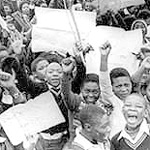This Day in History: November 12, 1980
Additional Date: November 12, 1980
The minister of (Black) education and training, Dr Ferdinand Hartzenberg, announced that compulsory education for Black children would be introduced in stages, with a first programme beginning near Pretoria. Implementation would start at the beginning of 1981 for children entering Grade 1 in selected schools. The pupils would have to continue at school until they passed Std 5 (now Grade 7) or reached the age of sixteen years. About 45 000 children were affected at 201 schools in 38 townships throughout the country. They were to receive free books and stationary at a cost of R4, 10 per child per year.
Many Black people were opposed to compulsory education because they had expected the government rather to upgrade the quality of Black education than making a system compulsory, which they had rejected over many years. In January 1981 the Azanian People's Organisation (AZAPO) strongly condemned the move, describing it as a ruse to force Black people to accept a system for which they had laid down their lives to reject in 1976. The minister rejected the allegation that compulsory education was being introduced to perpetuate an inferior education and stressed several advantages of the move. Though it was part of the Government's plan to ease tensions that had caused boycotts and violent unrest in Black schools during much of the previous year, the step led to renewed boycotts and protests against inequalities between education for Blacks and Whites.
Click here to read more about education in South Africa.
